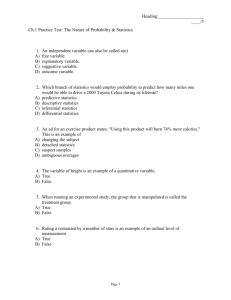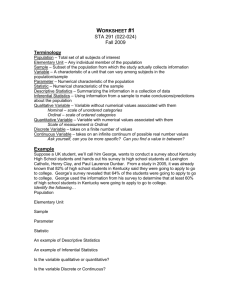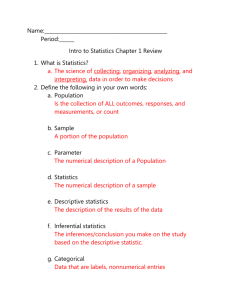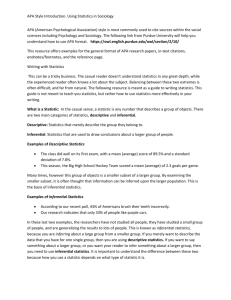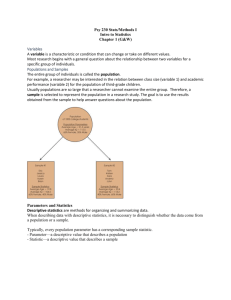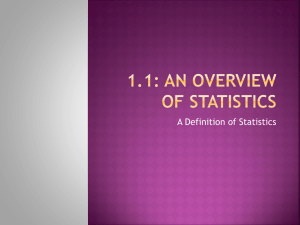Chapter 1 A Preview of Business Statistics
advertisement
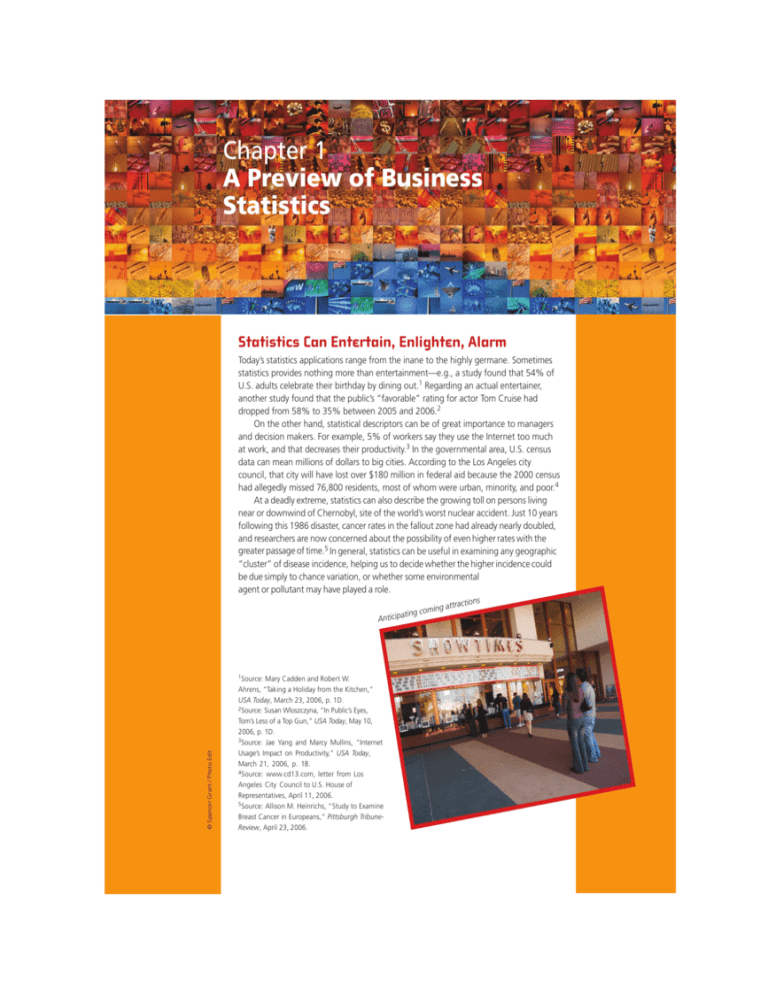
Chapter 1 A Preview of Business Statistics Statistics Can Entertain, Enlighten, Alarm Today’s statistics applications range from the inane to the highly germane. Sometimes statistics provides nothing more than entertainment—e.g., a study found that 54% of U.S. adults celebrate their birthday by dining out.1 Regarding an actual entertainer, another study found that the public’s “favorable” rating for actor Tom Cruise had dropped from 58% to 35% between 2005 and 2006.2 On the other hand, statistical descriptors can be of great importance to managers and decision makers. For example, 5% of workers say they use the Internet too much at work, and that decreases their productivity.3 In the governmental area, U.S. census data can mean millions of dollars to big cities. According to the Los Angeles city council, that city will have lost over $180 million in federal aid because the 2000 census had allegedly missed 76,800 residents, most of whom were urban, minority, and poor.4 At a deadly extreme, statistics can also describe the growing toll on persons living near or downwind of Chernobyl, site of the world’s worst nuclear accident. Just 10 years following this 1986 disaster, cancer rates in the fallout zone had already nearly doubled, and researchers are now concerned about the possibility of even higher rates with the greater passage of time.5 In general, statistics can be useful in examining any geographic “cluster” of disease incidence, helping us to decide whether the higher incidence could be due simply to chance variation, or whether some environmental agent or pollutant may have played a role. © Spencer Grant / Photo Edit tions g attrac g comin n ti a ip c Anti 1Source: Mary Cadden and Robert W. Ahrens, “Taking a Holiday from the Kitchen,” USA Today, March 23, 2006, p. 1D. 2Source: Susan Wloszczyna, “In Public’s Eyes, Tom’s Less of a Top Gun,” USA Today, May 10, 2006, p. 1D. 3Source: Jae Yang and Marcy Mullins, “Internet Usage’s Impact on Productivity,” USA Today, March 21, 2006, p. 1B. 4Source: www.cd13.com, letter from Los Angeles City Council to U.S. House of Representatives, April 11, 2006. 5Source: Allison M. Heinrichs, “Study to Examine Breast Cancer in Europeans,” Pittsburgh TribuneReview, April 23, 2006. 2 1.1 Part 1: Business Statistics: Introduction and Background INTRODUCTION Timely Topic, Tattered Image At this point in your college career, toxic dumping, armed robbery, fortune telling, and professional wrestling may all have more positive images than business statistics. If so, this isn’t unusual, since many students approach the subject believing that it will be either difficult or irrelevant. In a study of 105 beginning students’ attitudes toward statistics, 56% either strongly or moderately agreed with the statement, “I am afraid of statistics.”6 (Sorry to have tricked you like that, but you’ve just been introduced to a statistic, one that you’ll undoubtedly agree is neither difficult nor irrelevant.) Having recognized such possibly negative first impressions, let’s go on to discuss statistics in a more positive light. First, regarding ease of learning, the only thing this book assumes is that you have a basic knowledge of algebra. Anything else you need will be introduced and explained as we go along. Next, in terms of relevance, consider the unfortunates of Figure 1.1 and how just the slight change of a single statistic might have considerably influenced each individual’s fortune. What Is Business Statistics? Briefly defined, business statistics can be described as the collection, summarization, analysis, and reporting of numerical findings relevant to a business decision or situation. Naturally, given the great diversity of business itself, it’s not surprising that statistics can be applied to many kinds of business settings. We will be examining a wide spectrum of such applications and settings. Regardless of your eventual career destination, whether it be accounting or marketing, finance or politics, information science or human resource management, you’ll find the statistical techniques explained here are supported by examples and problems relevant to your own field. For the Consumer as Well as the Practitioner As a businessperson, you may find yourself involved with statistics in at least one of the following ways: (1) as a practitioner collecting, analyzing, and presenting FIGURE 1.1 Some have the notion that statistics can be irrelevant. As the plight of these individuals suggests, nothing could be further from the truth. Sidney Sidestreet, former quality assurance supervisor for an electronics manufacturer. The 20 microchips he inspected from the top of the crate all tested out OK, but many of the 14,980 on the bottom weren't quite so good. Lefty “H.R.” Jones, former professional baseball pitcher. Had an earned-run average of 12.4 last season, which turned out to be his last season. Walter Wickerbin, former newspaper columnist. Survey by publisher showed that 43% of readers weren't even aware of his column. Rhonda Rhodes, former vice president of engineering for a tire manufacturer. The company advertised a 45,000-mile tread life, but tests by a leading consumer magazine found most tires wore out in less than 20,000 miles. 6Source: Eleanor W. Jordan and Donna F. Stroup, “The Image of Statistics,” Collegiate News and Views, Spring 1984, p. 11. Chapter 1: A Preview of Business Statistics 3 findings based on statistical data or (2) as a consumer of statistical claims and findings offered by others, some of whom may be either incompetent or unethical. As you might expect, the primary orientation of this text will be toward the “how-to,” or practitioner, dimension of business statistics. After finishing this book, you should be both proficient and conversant in most of the popular techniques used in statistical data collection, analysis, and reporting. As a secondary goal, this book will help you protect yourself and your company as a statistical consumer. In particular, it’s important that you be able to deal with individuals who arrive at your office bearing statistical advice. Chances are, they’ll be one of the following: 1. Dr. Goodstat The good doctor has painstakingly employed the correct methodology for the situation and has objectively analyzed and reported on the information he’s collected. Trust him, he’s OK. 2. Stanley Stumbler Stanley means well, but doesn’t fully understand what he’s doing. He may have innocently employed an improper methodology and arrived at conclusions that are incorrect. In accepting his findings, you may join Stanley in flying blind. 3. Dr. Unethicus This character knows what he’s doing, but uses his knowledge to sell you findings that he knows aren’t true. In short, he places his own selfish interests ahead of both scientific objectivity and your informational needs. He varies his modus operandi and is sometimes difficult to catch. One result is inevitable: when you accept his findings, he wins and you lose. STATISTICS: YESTERDAY AND TODAY Yesterday Although statistical data have been collected for thousands of years, very early efforts typically involved simply counting people or possessions to facilitate taxation. This record-keeping and enumeration function remained dominant well into the 20th century, as this 1925 observation on the role of statistics in the commercial and political world of that time indicates: It is coming to be the rule to use statistics and to think statistically. The larger business units not only have their own statistical departments in which they collect and interpret facts about their own affairs, but they themselves are consumers of statistics collected by others. The trade press and government documents are largely statistical in character, and this is necessarily so, since only by the use of statistics can the affairs of business and of state be intelligently conducted. Business needs a record of its past history with respect to sales, costs, sources of materials, market facilities, etc. Its condition, thus reflected, is used to measure progress, financial standing, and economic growth. A record of business changes—of its rise and decline and of the sequence of forces influencing it—is necessary for estimating future developments.7 Note the brief reference to “estimating future developments” in the preceding quotation. In 1925, this observation was especially pertinent because a transition was in process. Statistics was being transformed from a relatively passive record 7Source: Horace Secrist, An Introduction to Statistical Methods, rev. ed. New York: Macmillan Company, 1925, p. 1. 1.2 4 Part 1: Business Statistics: Introduction and Background keeper and descriptor to an increasingly active and useful business tool, which would influence decisions and enable inferences to be drawn from sample information. Today Today, statistics and its applications are an integral part of our lives. In such diverse settings as politics, medicine, education, business, and the legal arena, human activities are both measured and guided by statistics. Our behavior in the marketplace generates sales statistics that, in turn, help companies make decisions on products to be retained, dropped, or modified. Likewise, auto insurance firms collect data on age, vehicle type, and accidents, and these statistics guide the companies toward charging extremely high premiums for teenagers who own or drive high-powered cars like the Chevrolet Corvette. In turn, the higher premiums influence human behavior by making it more difficult for teens to own or drive such cars. The following are additional examples where statistics are either guiding or measuring human activities. • • • Well beyond simply counting how many people live in the United States, the U.S. Census Bureau uses sampling to collect extensive information on income, housing, transportation, occupation, and other characteristics of the populace. The Bureau used to do this by means of a “long form” sent to 1 in 6 Americans every 10 years. Today, the same questions are asked in a 67-question monthly survey that is received by a total of about 3 million households each year. The resulting data are more recent and more useful than the decennial sampling formerly employed, and the data have a vital effect on billions of dollars in business decisions and federal funding.8 According to the International Dairy Foods Association, ice cream and related frozen desserts are consumed by more than 90% of the households in the United States. The most popular flavor is vanilla, which accounts for 26% of sales. Chocolate is a distant second, at 13% of sales.9 On average, U.S. stores lose $25 million each day to shoplifters. The problem becomes even worse when the national economy is weak, and more than half of those arrested for shoplifting are under the age of 25. Every day, 5400 people are detained for shoplifting.10 Throughout this text, we will be examining the multifaceted role of statistics as a descriptor of information, a tool for analysis, a means of reaching conclusions, and an aid to decision making. In the next section, after introducing the concept of descriptive versus inferential statistics, we’ll present further examples of the relevance of statistics in today’s world. exercises 1.1 What was the primary use of statistics in ancient 1.2 In what ways can business statistics be useful in times? today’s business environment? 8Source: Haya El Nasser, “Rolling Survey for 2010 Census Keeps Data Up to Date,” USA Today, January 17, 2005, p. 4A. 9Source: http://www.idfa.org, June 14, 2006. 10Source: http://witn.psu.edu/articles (show #2516 news summary), June 14, 2006. Chapter 1: A Preview of Business Statistics DESCRIPTIVE VERSUS INFERENTIAL STATISTICS As we have seen, statistics can refer to a set of individual numbers or numerical facts, or to general or specific statistical techniques. A further breakdown of the subject is possible, depending on whether the emphasis is on (1) simply describing the characteristics of a set of data or (2) proceeding from data characteristics to making generalizations, estimates, forecasts, or other judgments based on the data. The former is referred to as descriptive statistics, while the latter is called inferential statistics. As you might expect, both approaches are vital in today’s business world. Descriptive Statistics In descriptive statistics, we simply summarize and describe the data we’ve collected. For example, upon looking around your class, you may find that 35% of your fellow students are wearing Casio watches. If so, the figure “35%” is a descriptive statistic. You are not attempting to suggest that 35% of all college students in the United States, or even at your school, wear Casio watches. You’re merely describing the data that you’ve recorded. In the year 1900, the U.S. Postal Service operated 76,688 post offices, compared to just 27,505 in 2004.11 In 2005, the 1.26 billion common shares of McDonald’s Corporation each received a $0.67 dividend on net income of $2.04 per common share.12 Table 1.1 (page 6) provides additional examples of descriptive statistics. Chapters 2 and 3 will present a number of popular visual and statistical approaches to expressing the data we or others have collected. For now, however, just remember that descriptive statistics are used only to summarize or describe. Inferential Statistics In inferential statistics, sometimes referred to as inductive statistics, we go beyond mere description of the data and arrive at inferences regarding the phenomena or phenomenon for which sample data were obtained. For example, based partially on an examination of the viewing behavior of several thousand television households, the ABC television network may decide to cancel a prime-time television program. In so doing, the network is assuming that millions of other viewers across the nation are also watching competing programs. Political pollsters are among the heavy users of inferential statistics, typically questioning between 1000 and 2000 voters in an effort to predict the voting behavior of millions of citizens on election day. If you’ve followed recent presidential elections, you may have noticed that, although they contact only a relatively small number of voters, the pollsters are quite often “on the money” in predicting both the winners and their margins of victory. This accuracy, and the fact that it’s not simply luck, is one of the things that make inferential statistics a fascinating and useful topic. (For more examples of the relevance and variety of inferential statistics, refer to Table 1.1.) As you might expect, much of this text will be devoted to the concept and methods of inferential statistics. 11Source: Bureau of the Census, U.S. Department of Commerce, Statistical Abstract of the United States 2006, p. 729. 12Source: McDonald’s Corporation, Inc., 2005 Summary Annual Report. 5 1.3 6 Part 1: Business Statistics: Introduction and Background TABLE 1.1 Descriptive Statistics • Members of Congress accepted 372 privately financed trips during the first half of 2006. [p. 5A] • During the second quarter of 2006, media giant Time Warner reported revenues of $10.7 billion. [p. 3B] • Ford’s F-series pickup trucks remain the best-selling vehicles in America, but July sales were down 45.6% compared with the same period a year before. [p. 3B] • U.S. shipments of digital cameras totaled 6.3 million units during the first quarter of 2006, up 17% over the first quarter of 2005. [p. 1B] Inferential Statistics • A survey by the American Automobile Association found the average price for premium gasoline was $3.302, slightly down from $3.307 the previous day. [p. 1A] • According to a Hartford Financial Services Group survey of 2245 parents of high school and college students, 20% of the parents said they didn’t expect their child to be responsible for any of his or her financial costs of going to college. [p. 1B] • Survey results indicated that 13.5% of persons under 18 keep a personal blog, display photos on the Web, or maintain their own website. [p. 1D] • In a survey of environmental responsibility, 37.8% of the respondents said environmentally friendly products are “very important” to them and their family. [p. 1B] Source: USA Today, August 3, 2006. The page references are shown in brackets. Key Terms for Inferential Statistics In surveying the political choices of a small number of eligible voters, political pollsters are using a sample of voters selected from the population of all eligible voters. Based on the results observed in the sample, the researchers then proceed to make inferences on the political choices likely to exist in this larger population of eligible voters. A sample result (e.g., 46% of the sample favor Charles Grady for president) is referred to as a sample statistic and is used in an attempt to estimate the corresponding population parameter (e.g., the actual, but unknown, national percentage of voters who favor Mr. Grady). These and other important terms from inferential statistics may be defined as follows: • Population Sometimes referred to as the universe, this is the entire set of people or objects of interest. It could be all adult citizens in the United States, all commercial pilots employed by domestic airlines, or every roller bearing ever produced by the Timken Company. A population may refer to things as well as people. Before beginning a study, it is important to clearly define the population involved. For example, in a given study, a retailer may decide to define “customer” as all those who enter her store between 9 A.M. and 5 P.M. next Wednesday. • Sample This is a smaller number (a subset) of the people or objects that exist within the larger population. The retailer in the preceding definition may Chapter 1: A Preview of Business Statistics decide to select her sample by choosing every 10th person entering the store between 9 A.M. and 5 P.M. next Wednesday. A sample is said to be representative if its members tend to have the same characteristics (e.g., voting preference, shopping behavior, age, income, educational level) as the population from which they were selected. For example, if 45% of the population consists of female shoppers, we would like our sample to also include 45% females. When a sample is so large as to include all members of the population, it is referred to as a complete census. • Statistic This is a measured characteristic of the sample. For example, our retailer may find that 73% of the sample members rate the store as having higher-quality merchandise than the competitor across the street. The sample statistic can be a measure of typicalness or central tendency, such as the mean, median, mode, or proportion, or it may be a measure of spread or dispersion, such as the range and standard deviation: The sample mean is the arithmetic average of the data. This is the sum of the data divided by the number of values. For example, the mean of $4, $3, and $8 can be calculated as ($4 ⫹ $3 ⫹ $8)/3, or $5. The sample median is the midpoint of the data. The median of $4, $3, and $8 would be $4, since it has just as many values above it as below it. The sample mode is the value that is most frequently observed. If the data consist of the numbers 12, 15, 10, 15, 18, and 21, the mode would be 15 because it occurs more often than any other value. The sample proportion is simply a percentage expressed as a decimal fraction. For example, if 75.2% is converted into a proportion, it becomes 0.752. The sample range is the difference between the highest and lowest values. For example, the range for $4, $3, and $8 is ($8 ⫺ $3), or $5. The sample standard deviation, another measure of dispersion, is obtained by applying a standard formula to the sample values. The formula for the standard deviation is covered in Chapter 3, as are more detailed definitions and examples of the other measures of central tendency and dispersion. • Parameter This is a numerical characteristic of the population. If we were to take a complete census of the population, the parameter could actually be measured. As discussed earlier, however, this is grossly impractical for most business research. The purpose of the sample statistic is to estimate the value of the corresponding population parameter (e.g., the sample mean is used to estimate the population mean). Typical parameters include the population mean, median, proportion, and standard deviation. As with sample statistics, these will be discussed in Chapter 3. For our retailer, the actual percentage of the population who rate her store’s merchandise as being of higher quality is unknown. (This unknown quantity is the parameter in this case.) However, she may use the sample statistic (73%) as an estimate of what this percentage would have been had she taken the time, expense, and inconvenience to conduct a census of all customers on the day of the study. 7 8 Part 1: Business Statistics: Introduction and Background exercises 1.3 What is the difference between descriptive statistics 1.5 An article in Runner’s World magazine described a and inferential statistics? Which branch is involved when a state senator surveys some of her constituents in order to obtain guidance on how she should vote on a piece of legislation? study that compared the cardiovascular responses of 20 adult subjects for exercises on a treadmill, on a minitrampoline, and jogging in place on a carpeted surface. Researchers found average heart rates were significantly less on the minitrampoline than for the treadmill and stationary jogging. Does this information represent descriptive statistics or inferential statistics? Why? 1.4 In 2002, the Cinergy Corporation sold 35,615 million cubic feet of gas to residential customers, an increase of 1.1% over the previous year. Does this information represent descriptive statistics or inferential statistics? Why? SOURCE: Cinergy Corporation, Annual Report 2002, p. 110. 1.4 SOURCE: Kate Delhagen, “Health Watch,” Runner's World, August 1987, p. 21. TYPES OF VARIABLES AND SCALES OF MEASUREMENT Qualitative Variables Some of the variables associated with people or objects are qualitative in nature, indicating that the person or object belongs in a category. For example: (1) you are either male or female; (2) you have either consumed Dad’s Root Beer within the past week or you have not; (3) your next television set will be either color or black and white; and (4) your hair is likely to be brown, black, red, blonde, or gray. While some qualitative variables have only two categories, others may have three or more. Qualitative variables, also referred to as attributes, typically involve counting how many people or objects fall into each category. In expressing results involving qualitative variables, we describe the percentage or the number of persons or objects falling into each of the possible categories. For example, we may find that 35% of grade-school children interviewed recognize a photograph of Ronald McDonald, while 65% do not. Likewise, some of the children may have eaten a Big Mac hamburger at one time or another, while others have not. Quantitative Variables Quantitative variables enable us to determine how much of something is possessed, not just whether it is possessed. There are two types of quantitative variables: discrete and continuous. Discrete quantitative variables can take on only certain values along an interval, with the possible values having gaps between them. Examples of discrete quantitative variables would be the number of employees on the payroll of a manufacturing firm, the number of patrons attending a theatrical performance, or the number of defectives in a production sample. Discrete variables in business statistics usually consist of observations that we can count and often have integer values. Fractional values are also possible, however. For example, in observing the number of gallons of milk that shoppers buy during a trip to a U.S. supermarket, the possible values will be 0.25, 0.50, 0.75, 1.00, 1.25, 1.50, and so on. This is because milk is typically sold in 1-quart containers as well as gallons. A shopper will not be able to purchase a container of milk labeled “0.835 gallons.” The distinguishing feature of discrete variables is that gaps exist between the possible values. Chapter 1: A Preview of Business Statistics 9 Continuous quantitative variables can take on a value at any point along an interval. For example, the volume of liquid in a water tower could be any quantity between zero and its capacity when full. At a given moment, there might be 325,125 gallons, 325,125.41 gallons, or even 325,125.413927 gallons, depending on the accuracy with which the volume can be measured. The possible values that could be taken on would have no gaps between them. Other examples of continuous quantitative variables are the weight of a coal truck, the Dow Jones Industrial Average, the driving distance from your school to your home town, and the temperature outside as you’re reading this book. The exact values each of these variables could take on would have no gaps between them. Scales of Measurement Assigning a numerical value to a variable is a process called measurement. For example, we might look at the thermometer and observe a reading of 72.5 degrees Fahrenheit or examine a box of lightbulbs and find that 3 are broken. The numbers 72.5 and 3 would constitute measurements. When a variable is measured, the result will be in one of the four levels, or scales, of measurement— nominal, ordinal, interval, or ratio—summarized in Figure 1.2. The scale to which the measurements belong will be important in determining appropriate methods for data description and analysis. The Nominal Scale The nominal scale uses numbers only for the purpose of identifying membership in a group or category. Computer statistical analysis is greatly facilitated by the use of numbers instead of names. For example, Louisiana’s Entergy Corporation lists four types of domestic electric customers.13 In its computer records, the company might use “1” to identify residential customers, “2” for commercial customers, “3” for industrial customers, and “4” for government customers. Aside from identification, these numbers have no arithmetic meaning. The Ordinal Scale In the ordinal scale, numbers represent “greater than” or “less than” measurements, such as preferences or rankings. For example, consider the following FIGURE 1.2 13Source: Nominal Each number represents a category Ordinal Greater than and less than relationships Interval and Ratio and Units of measurement Entergy Corporation, 2005 Annual Report. and Absolute zero point The methods through which statistical data can be analyzed depend on the scale of measurement of the data. Each of the four scales has its own characteristics. 10 Part 1: Business Statistics: Introduction and Background Association of Tennis Professionals singles rankings for female tennis players:14 1. 2. 3. 4. Amelie Mauresmo Kim Clijsters Justine Henin-Hardenne Maria Sharapova In the ordinal scale, numbers are viewed in terms of rank (i.e., greater than, less than), but do not represent distances between objects. For example, we cannot say that the distance between Amelie Mauresmo and Kim Clijsters is the same as the distance between Kim Clijsters and Justine Henin-Hardenne. This is because the ordinal scale has no unit of measurement. The Interval Scale The interval scale not only includes “greater than” and “less than” relationships, but also has a unit of measurement that permits us to describe how much more or less one object possesses than another. The Fahrenheit temperature scale represents an interval scale of measurement. We not only know that 90 degrees Fahrenheit is hotter than 70 degrees, and that 70 degrees is hotter than 60 degrees, but can also state that the distance between 90 and 70 is twice the distance between 70 and 60. This is because degree markings serve as the unit of measurement. In an interval scale, the unit of measurement is arbitrary, and there is no absolute zero level where none of a given characteristic is present. Thus, multiples of measured values are not meaningful—e.g., 2 degrees Fahrenheit is not twice as warm as 1 degree. On questionnaire items like the following, business research practitioners typically treat the data as interval scale since the same physical and numerical distances exist between alternatives: Kmart prices are [ ] 1 low [ ] 2 [ ] 3 [ ] 4 [ ] 5 high The Ratio Scale The ratio scale is similar to the interval scale, but has an absolute zero and multiples are meaningful. Election votes, natural gas consumption, return on investment, the speed of a production line, and FedEx Corporation’s average daily delivery of 5,868,000 packages during 200515 are all examples of the ratio scale of measurement. exercises 1.6 What is the difference between a qualitative vari- 1.8 The Acme School of Locksmithing has been able and a quantitative variable? When would each be appropriate? accredited for the past 15 years. Discuss how this information might be interpreted as a a. qualitative variable. b. quantitative variable. 1.7 What is the difference between discrete and continu- ous variables? Under what circumstances would each be applicable? 14Source: 15Source: ESPN.com, June 14, 2006. FedEx Corporation, 2005 Annual Report, p. 3. Chapter 1: A Preview of Business Statistics 11 1.9 Jeff Bowlen, a labor relations expert, has collected 1.10 The Snowbird Ski Lodge attracts skiers from several information on strikes in various industries. a. Jeff says, “Industry A has been harder hit by strikes than Industry B.” In what scale of measurement is this information? Why? b. Industry C has lost 10.8 days per worker, while Industry D has lost 14.5 days per worker. In what scale of measurement is this information? Why? New England states. For each of the following scales of measurement, provide one example of information that might be relevant to the lodge’s business. a. Nominal b. Ordinal c. Interval d. Ratio 1.5 STATISTICS IN BUSINESS DECISIONS One aspect of business in which statistics plays an especially vital role is decision making. Every year, U.S. businesses risk billions of dollars in important decisions involving plant expansions, new product development, personnel selection, quality assurance, production techniques, supplier choices, and many others. These decisions almost always involve an element of uncertainty. Competitors, government, technology, and the social and economic environment, along with sometimes capricious consumers and voters, constitute largely uncontrollable factors that can sometimes foil the best-laid plans. Prior to making decisions, companies often collect information through a series of steps called the research process. The steps include: (1) defining the problem in specific terms that can be answered by research, (2) deciding on the type of data required, (3) determining through what means the data will be obtained, (4) planning for the collection of data and, if necessary, selection of a sample, (5) collecting and analyzing the data, (6) drawing conclusions and reporting the findings, and (7) following through with decisions that take the findings into consideration. Business and survey research, discussed more fully in Chapter 4, provides both descriptive and inferential statistics that can improve business decisions in many kinds of situations. exercises 1.11 Restaurants sometimes provide “customer reaction” 1.12 What kinds of statistical data might a burglar alarm cards so that customers can evaluate their dining experience at the establishment. What kinds of decisions might be made on the basis of this information? company employ in trying to convince urban homeowners to purchase its product? BUSINESS STATISTICS: TOOLS VERSUS TRICKS The techniques of business statistics are a valuable tool for the enhancement of business operations and success. Appropriately, the major emphasis of this text will be to acquaint you with these techniques and to develop your proficiency in using them and interpreting their results. On the other hand, as suggested earlier, these same techniques can be abused for personal or corporate gain. Improperly used, statistics can become an effective weapon with which to persuade or manipulate others into beliefs or behaviors that 1.6 12 Part 1: Business Statistics: Introduction and Background we’d like them to adopt. Note too that, even when they are not intentionally misused, the results of statistical research and analyses can depend a lot on when and how they were conducted, as Statistics in Action 1.1 shows. Unlike many other pursuits, such as defusing torpedoes, climbing mountains, or wrestling alligators, improper actions in business statistics can sometimes work in your favor. (As embezzlers know, this can also be true in accounting.) Naturally, we don’t expect that you’ll use your knowledge of statistics to manipulate unknowing customers and colleagues, but you should be aware of how others may be using statistics in an attempt to manipulate you. Remember that one of the key goals of this text is to make you an informed consumer of statistical information generated by others. In general, when you are presented with statistical data or conclusions that have been generated by others, you should ask yourself this key question: Who carried out this study and analyzed the data, and what benefits do they stand to gain from the conclusions reached? exercises 1.13 The text claims that a company or organization might actually benefit when one of its employees uses statistics incorrectly. How can this be? who wishes to avoid accepting biased results, what single question should be foremost in your mind as you begin reading the article? 1.14 The headline of an article in your daily newspaper begins “Research Study Reveals. . . .” As a statistics student 1.7 SUMMARY Business statistics can be defined as the collection, summarization, analysis, and reporting of numerical findings relevant to a business decision or situation. As businesspersons and citizens, we are involved with statistics either as practitioners or as consumers of statistical claims and findings offered by others. Very early statistical efforts primarily involved counting people or possessions for taxation purposes. More recently, statistical methods have been applied in all facets of business as a tool for analysis and reporting, for reaching conclusions based on observed data, and as an aid to decision making. Statistics can be divided into two branches: descriptive and inferential. Descriptive statistics focuses on summarizing and describing data that have been collected. Inferential statistics goes beyond mere description and, based on sample data, seeks to reach conclusions or make predictions regarding the population from which the sample was drawn. The population is the entire set of all people or objects of interest, with the sample being a subset of this group. A sample is said to be representative if its members tend to have the same characteristics as the larger population. A census involves measuring all people or objects in the population. The sample statistic is a characteristic of the sample that is measured; it is often a mean, median, mode, proportion, or a measure of variability such as the range or standard deviation. The population parameter is the population characteristic that the sample statistic attempts to estimate. Variables can be either qualitative or quantitative. Qualitative variables indicate whether a person or object possesses a given attribute, while quantitative variables statistics statistics in in action action 1.1 1.1 High Stakes on the Interstate: Car Phones and Accidents Do car phones contribute to auto accidents? Preliminary research says they may. In one study, the researchers randomly selected 100 New York motorists who had been in an accident and 100 who had not. Those who had been in an accident were30%morelikelytohaveacellphone.In another study, published in The New England Journal of Medicine, researchers found that cell phone use while driving quadrupled the chance of having an accident, a risk increase comparable to driving with one’s blood alcohol level at the legal limit. The Cellular Telecommunications Industry Association has a natural stake in this issue. There are currently more than 180 million cell phone subscribers, tens of thousands are signing up daily, and a high percentage of subscribers use their phones while driving. The association tends to dismiss accident studies such as the ones above as limited, flawed, and having research shortcomings. One thing is certain: more research is on the way. It will be performed by objective researchers as well as by individuals and organizations with a vested interest in the results. Future studies, their methodologies, the allegiances of their sponsors, and the interpretation of their results will play an important role in the safety of our highways and the economic vitality of our cellular phone industry. Sources: “Survey: Car Phone Users Run Higher Risk of Crashes,” Indiana Gazette, March 19, 1996, p. 10; “Ban Car Phones?” USA Today, April 27, 2000, p. 16A; “Get Off the Cell Phone,” Tribune-Review, January 29, 2000, p. A6; and “Cell Phone Use Booms, Despite Uneven Service,” USA Today, March 14, 2005, p. 2B. express how much of an attribute is possessed. Discrete quantitative variables can take on only certain values along an interval, with the possible values having gaps between them, while continuous quantitative variables can take on a value at any point along an interval. When a variable is measured, a numerical value is assigned to it, and the result will be in one of four levels, or scales, of measurement — nominal, ordinal, interval, or ratio. The scale to which the measurements belong will be important in determining appropriate methods for data description and analysis. By helping to reduce the uncertainty posed by largely uncontrollable factors, such as competitors, government, technology, the social and economic environment, and often unpredictable consumers and voters, statistics plays a vital role in business decision making. Although statistics is a valuable tool in business, its techniques can be abused or misused for personal or corporate gain. This makes it especially important for businesspersons to be informed consumers of statistical claims and findings. chapter exercises 1.15 A research firm observes that men are twice as likely as women to watch the Super Bowl on television. Does this information represent descriptive statistics or inferential statistics? Why? 1.16 For each of the following, indicate whether the appropriate variable would be qualitative or quantitative. If you identify the variable as quantitative, indicate whether it would be discrete or continuous. a. Whether you own a Panasonic television set b. Your status as either a full-time or a part-time student c. The number of people who attended your school’s graduation last year d. The price of your most recent haircut e. Sam’s travel time from his dorm to the student union f. The number of students on campus who belong to a social fraternity or sorority 1.17 What kinds of statistical data play a role in an auto insurance firm’s decision on the annual premium you’ll pay for your policy? 1.18 For each of the following, indicate the scale of mea- surement that best describes the information. a. In January 2003, Dell Corporation had approximately 39,100 employees. SOURCE: Dell Corporation, 2003 Year in Review, p. 21. 14 b. USA Today reports that the previous day’s highest temperature in the United States was 115 degrees in Death Valley, California. SOURCE: USA Today, June 2, 2003, p. 12A. c. An individual respondent answers “yes” when asked if TV contributes to violence in the United States. d. In a comparison test of family sedans, a magazine rates the Toyota Camry higher than the VW Passat. 1.19 Most undergraduate business students will not go on to become actual practitioners of statistical research and analysis. Considering this fact, why should such individuals bother to become familiar with business statistics? 1.20 Bill scored 1200 on the Scholastic Aptitude Test and entered college as a physics major. As a freshman, he changed to business because he thought it was more interesting. Because he made the dean’s list last semester, his parents gave him $30 to buy a new Casio calculator. For this situation, identify at least one piece of information in the a. nominal scale of measurement. b. ordinal scale of measurement. c. interval scale of measurement. d. ratio scale of measurement. Part 1: Business Statistics: Introduction and Background 1.21 Roger Amster teaches an English course in which 40 students are enrolled. After yesterday’s class, Roger questioned the 5 students who always sit in the back of the classroom. Three of the 5 said “yes” when asked if they would like A Tale of Two Cities as the next class reading assignment. a. Identify the population and the sample in this situation. b. Is this likely to be a representative sample? If not, why not? 1.22 In studying the performance of the company’s stock investments over the past year, the research manager of a mutual fund company finds that only 43% of the stocks returned more than the rate that had been expected at the beginning of the year. a. Could this information be viewed as representing the nominal scale of measurement? If so, explain your reasoning. If not, why not? b. Could this information be viewed as representing the ratio scale of measurement? If so, explain your reasoning. If not, why not?
